Unit 5 Look into Science.Lesson 29 DNA—The Story of You.课件
文档属性
| 名称 | Unit 5 Look into Science.Lesson 29 DNA—The Story of You.课件 | 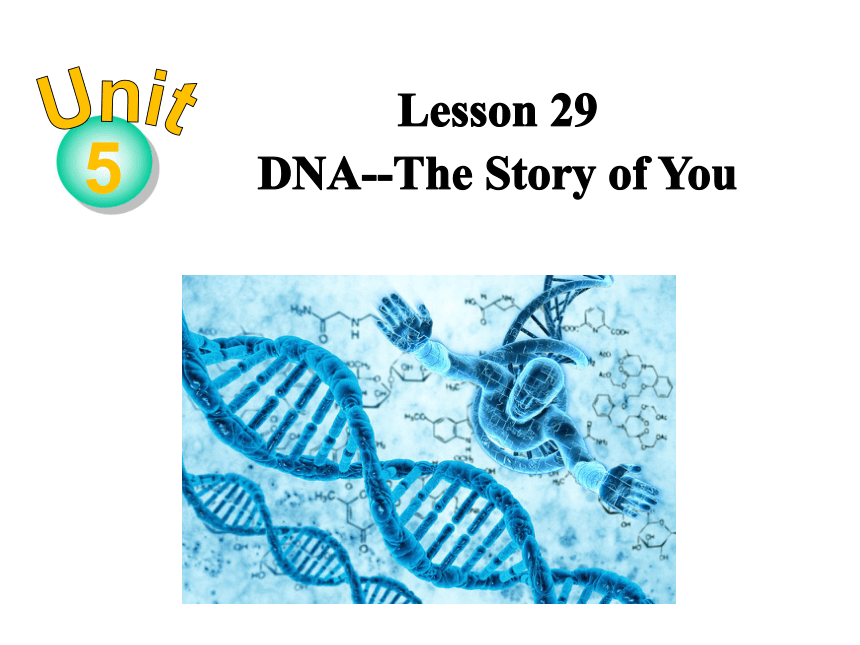 | |
| 格式 | zip | ||
| 文件大小 | 4.8MB | ||
| 资源类型 | 教案 | ||
| 版本资源 | 冀教版 | ||
| 科目 | 英语 | ||
| 更新时间 | 2018-04-23 12:55:09 | ||
图片预览

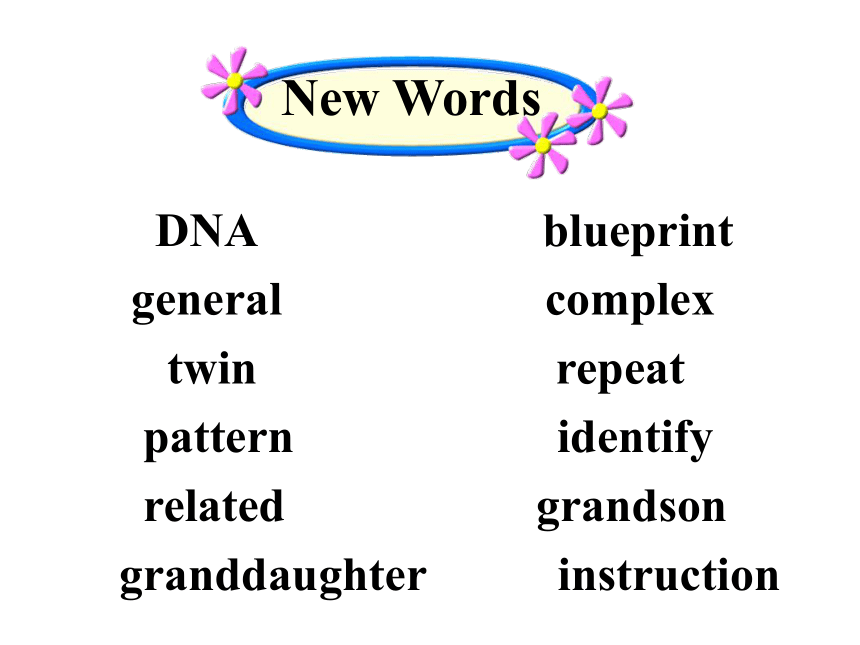
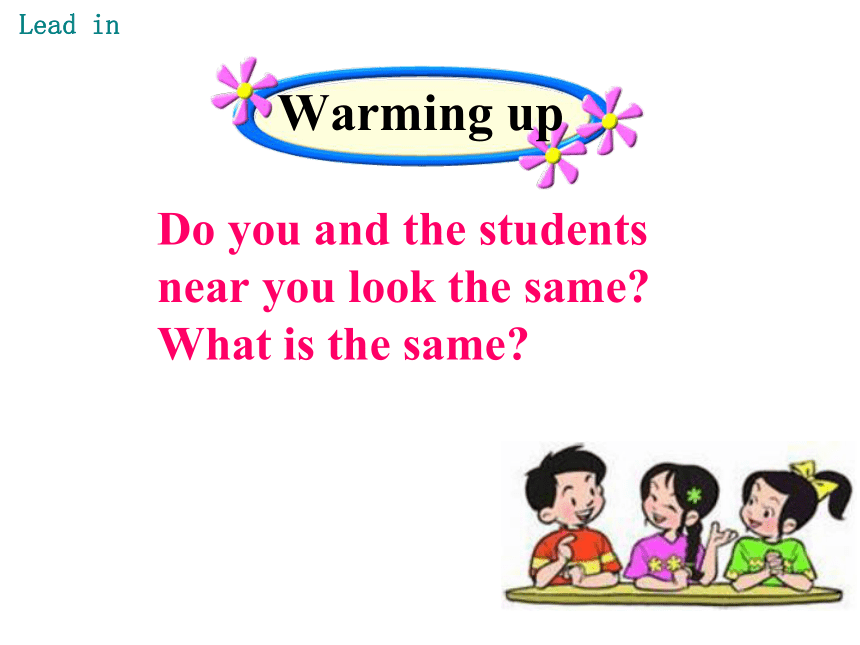
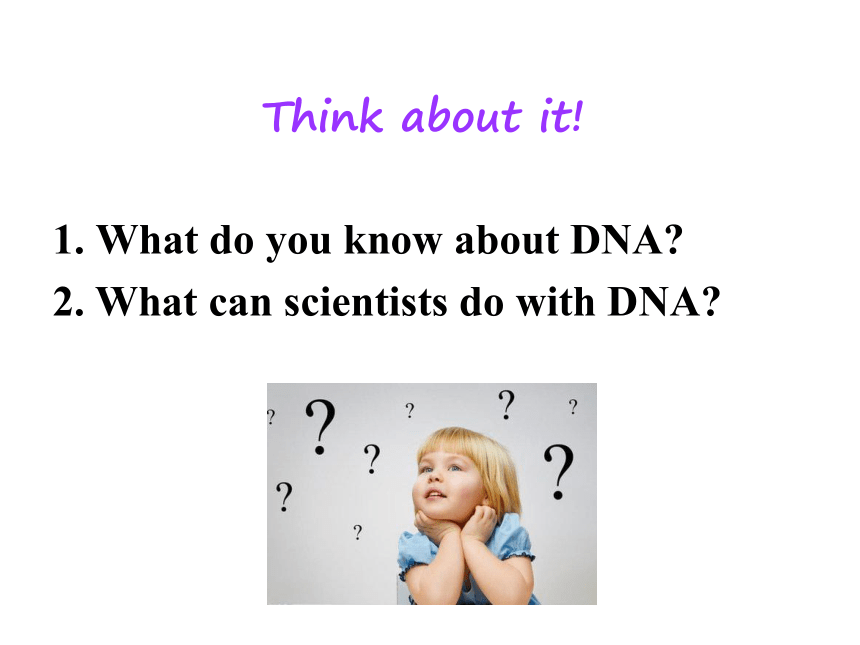
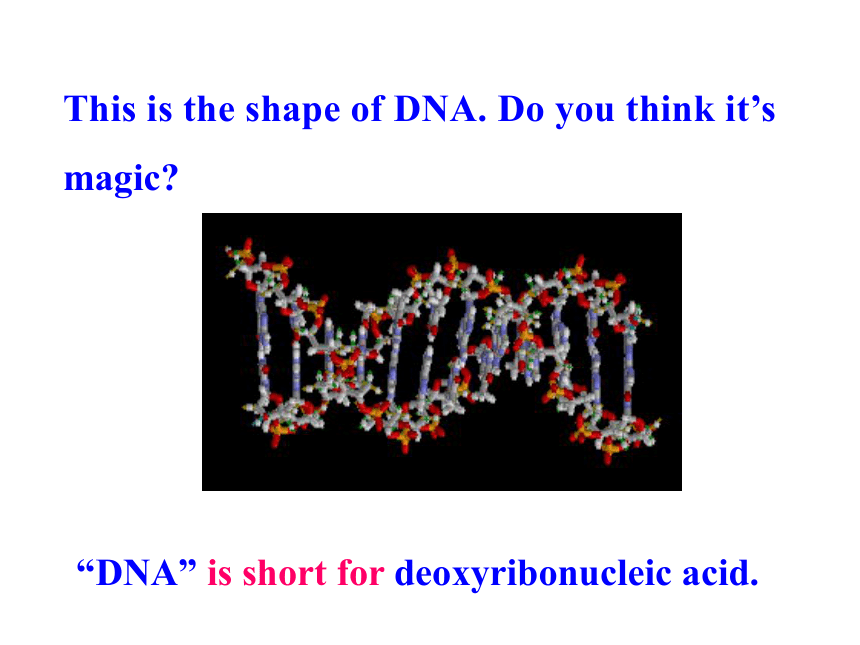
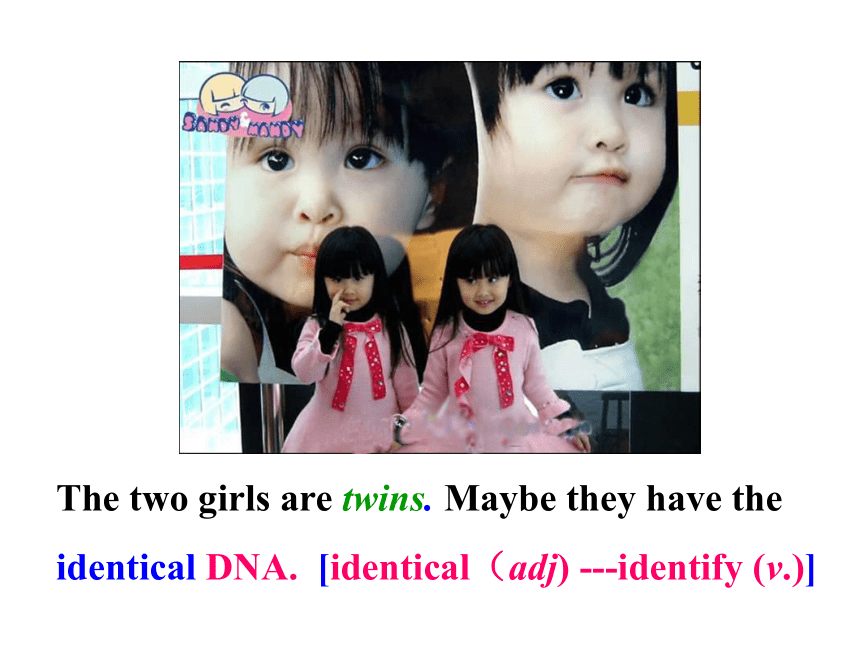

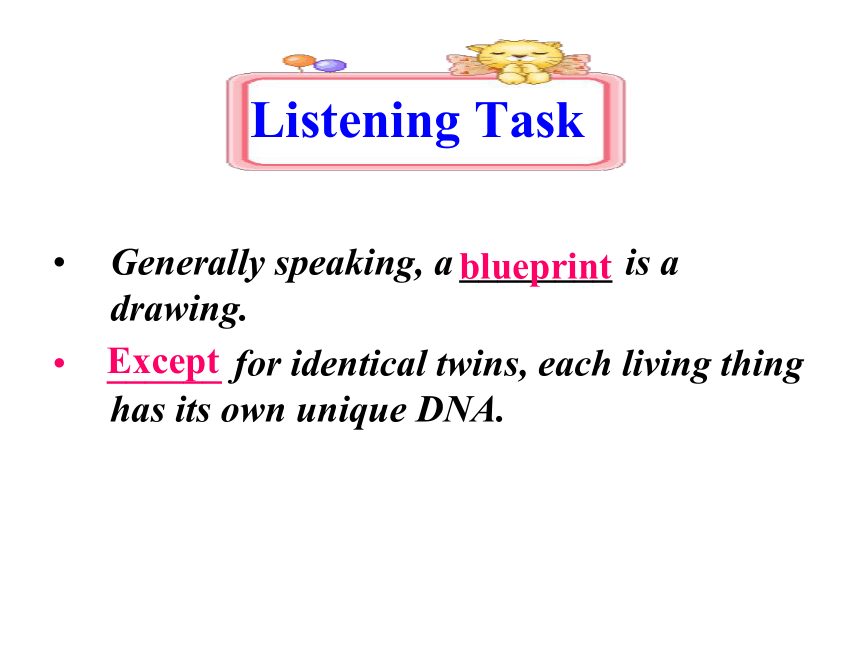
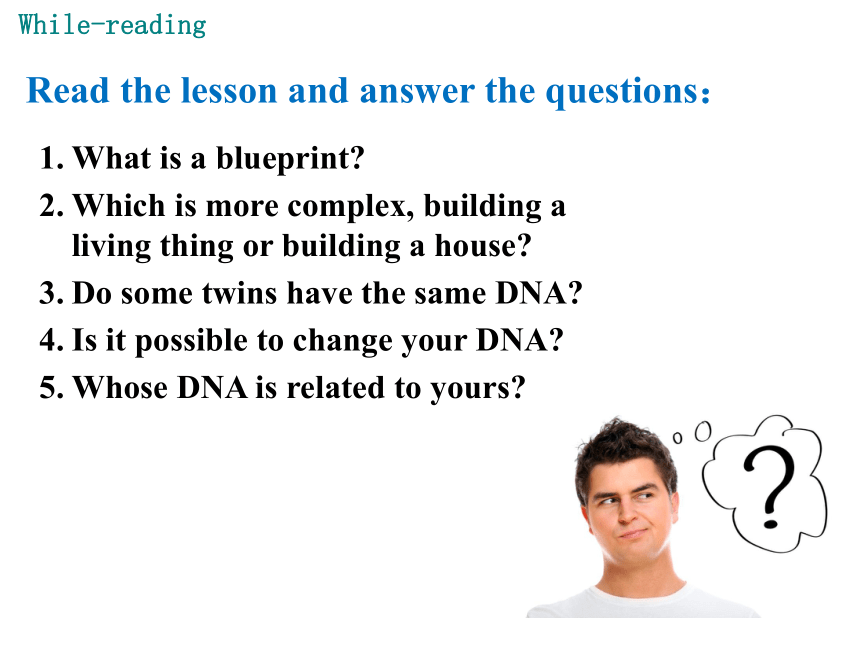
文档简介
课件23张PPT。5UnitLesson 29
DNA--The Story of You DNA blueprint
general complex
twin repeat
pattern identify
related grandson
granddaughter instructionNew WordsDo you and the students near you look the same? What is the same? Warming upLead inThink about it!
What do you know about DNA?
2. What can scientists do with DNA?This is the shape of DNA. Do you think it’s magic?“DNA” is short for deoxyribonucleic acid.The two girls are twins. Maybe they have the identical DNA. [identical(adj) ---identify (v.)]Why?Fang Zuming looks like his father—Cheng Long. Listening TaskGenerally speaking, a ________ is a drawing.
______ for identical twins, each living thing has its own unique DNA.blueprintExceptWhile-readingRead the lesson and answer the questions:What is a blueprint?
Which is more complex, building a living thing or building a house?
Do some twins have the same DNA?
Is it possible to change your DNA?
Whose DNA is related to yours?What is a blueprint?
Which is more complex, building a living thing or building a house?
Do some twins have the same DNA?
It’s a drawing that shows how to put a house together with many different parts.Building a living thing is far more complex than building a house.Yes, they are.4. Is it possible to change your DNA?
5. Whose DNA is related to yours?In the future, scientists might be able to change my DNA.My parents and grandparents. 1. But building a living thing is far more complex than building a house. 比较级前可以用much, even, still, far, a bit, a little, a lot 等词加以修饰。This unit is much easier than that one. 这个单元比那个单元容易得多。2. own 的用法
1)adj. 自己的 (用在所有格后,加强语气)
Now ask the same questions about your own teachers.
She makes all her own clothes.
2) vt. 有,拥有 其名词形式为owner,意为主人,所有者。
— Who owns the bike?
—Jackie. He is the owner of it.
3. except for =apart from 除……以外,只是 表示从整体中排除一小部分,前后对比的东西不同类 。except =but “除了”前后对比的东西同类
常与all , every ,no,not, any等连用。besides 表示“除……之外,还有”,即包含后面提到的内容。
eg:He is a good man except for hot temper.
I have said goodbye to all the teachers except Mr. Wang.
Besides Tom, five other boys also passed the exam.
4. not only ... but also ... 不但……而且……
连接两个相同的成分,也可以连接两个分句。当接两个主语时,谓语动词和后面主语保持一致。
e.g. He likes not only English but also math.
Not only you but also I am a teacher.
5. related to 涉及…… 的;与……有关的,是relate的过去分词,常做后置定语修饰前边名词。类似于called,named这样的过去分词。也可和be 动词构成固定表达 be related to ……,意为“和(与)……相关,有……关系。 ”
e.g. I have a book related to the Autumn Harvest Uprising.
The story is related to the Second World War.Post-readingFree TalkIs it a good idea to change the DNA of the food we eat?WritingWrite down your ideas……PracticeFill in each blank with the proper word.
1. This is the __________(identify) hotel that we stayed in last year.
2. Your brothers are people _________(relate) to you.
3. Do you know who is the _________(own) of the house?
4. Your body uses this pattern _________ (build) itself.identical relatedownerto build5. You have your own DNA, but it repeats the patterns from your __________(parent) DNA.
6. Some health problems come from your family’s DNA. _________(science) can look for these problems in your DNA. parents’Scientists根据汉语意思完成句子,每空一词:
1. 我们用蓝图建造房子。
We _______ a blueprint ______ _______ a house.
2. 除了窗子小外,这座房子很漂亮。
The house is beautiful ______ _____ the small
windows.
3. 你的头发和皮肤有同样的DNA。
Your hair has ______ _______ _______ _____ your skin.
4. 她不但会唱歌,而且会跳舞。
She can _____ ______ sing ______ ________ dance.use to buildexcept forthe same DNA asnot onlybut also
Choosing the correct answers
1.Your composition is quite good A a few spelling mistakes.
A:except for B:except C:beside D:besides
2. Neither they nor I D good at singing.
A. are B. be C. is D. am
3.The teacher has given the answers D the questions.
A. with B. for C. of D. to
4.Both my father and I A in the country.
A. enjoys living B. enjoy to live
C. enjoys to live D. enjoy living
6.From your DNA, scientists can identify you and people A to you .
A. related B. relates C. relating D. relate 5.Kate has the B color of hair her sister.
A. same to B. same as
C. identical as D. same with
HomeworkHomework1. Write a passage about DNA, try to tell what it is, where it is from, what things you show your parents’ DNA?
2. Preview Lesson 30.
DNA--The Story of You DNA blueprint
general complex
twin repeat
pattern identify
related grandson
granddaughter instructionNew WordsDo you and the students near you look the same? What is the same? Warming upLead inThink about it!
What do you know about DNA?
2. What can scientists do with DNA?This is the shape of DNA. Do you think it’s magic?“DNA” is short for deoxyribonucleic acid.The two girls are twins. Maybe they have the identical DNA. [identical(adj) ---identify (v.)]Why?Fang Zuming looks like his father—Cheng Long. Listening TaskGenerally speaking, a ________ is a drawing.
______ for identical twins, each living thing has its own unique DNA.blueprintExceptWhile-readingRead the lesson and answer the questions:What is a blueprint?
Which is more complex, building a living thing or building a house?
Do some twins have the same DNA?
Is it possible to change your DNA?
Whose DNA is related to yours?What is a blueprint?
Which is more complex, building a living thing or building a house?
Do some twins have the same DNA?
It’s a drawing that shows how to put a house together with many different parts.Building a living thing is far more complex than building a house.Yes, they are.4. Is it possible to change your DNA?
5. Whose DNA is related to yours?In the future, scientists might be able to change my DNA.My parents and grandparents. 1. But building a living thing is far more complex than building a house. 比较级前可以用much, even, still, far, a bit, a little, a lot 等词加以修饰。This unit is much easier than that one. 这个单元比那个单元容易得多。2. own 的用法
1)adj. 自己的 (用在所有格后,加强语气)
Now ask the same questions about your own teachers.
She makes all her own clothes.
2) vt. 有,拥有 其名词形式为owner,意为主人,所有者。
— Who owns the bike?
—Jackie. He is the owner of it.
3. except for =apart from 除……以外,只是 表示从整体中排除一小部分,前后对比的东西不同类 。except =but “除了”前后对比的东西同类
常与all , every ,no,not, any等连用。besides 表示“除……之外,还有”,即包含后面提到的内容。
eg:He is a good man except for hot temper.
I have said goodbye to all the teachers except Mr. Wang.
Besides Tom, five other boys also passed the exam.
4. not only ... but also ... 不但……而且……
连接两个相同的成分,也可以连接两个分句。当接两个主语时,谓语动词和后面主语保持一致。
e.g. He likes not only English but also math.
Not only you but also I am a teacher.
5. related to 涉及…… 的;与……有关的,是relate的过去分词,常做后置定语修饰前边名词。类似于called,named这样的过去分词。也可和be 动词构成固定表达 be related to ……,意为“和(与)……相关,有……关系。 ”
e.g. I have a book related to the Autumn Harvest Uprising.
The story is related to the Second World War.Post-readingFree TalkIs it a good idea to change the DNA of the food we eat?WritingWrite down your ideas……PracticeFill in each blank with the proper word.
1. This is the __________(identify) hotel that we stayed in last year.
2. Your brothers are people _________(relate) to you.
3. Do you know who is the _________(own) of the house?
4. Your body uses this pattern _________ (build) itself.identical relatedownerto build5. You have your own DNA, but it repeats the patterns from your __________(parent) DNA.
6. Some health problems come from your family’s DNA. _________(science) can look for these problems in your DNA. parents’Scientists根据汉语意思完成句子,每空一词:
1. 我们用蓝图建造房子。
We _______ a blueprint ______ _______ a house.
2. 除了窗子小外,这座房子很漂亮。
The house is beautiful ______ _____ the small
windows.
3. 你的头发和皮肤有同样的DNA。
Your hair has ______ _______ _______ _____ your skin.
4. 她不但会唱歌,而且会跳舞。
She can _____ ______ sing ______ ________ dance.use to buildexcept forthe same DNA asnot onlybut also
Choosing the correct answers
1.Your composition is quite good A a few spelling mistakes.
A:except for B:except C:beside D:besides
2. Neither they nor I D good at singing.
A. are B. be C. is D. am
3.The teacher has given the answers D the questions.
A. with B. for C. of D. to
4.Both my father and I A in the country.
A. enjoys living B. enjoy to live
C. enjoys to live D. enjoy living
6.From your DNA, scientists can identify you and people A to you .
A. related B. relates C. relating D. relate 5.Kate has the B color of hair her sister.
A. same to B. same as
C. identical as D. same with
HomeworkHomework1. Write a passage about DNA, try to tell what it is, where it is from, what things you show your parents’ DNA?
2. Preview Lesson 30.
同课章节目录
- Unit 1 Stay Healthy
- Lesson 1 What's Wrong,Danny?
- Lesson 2 A Visit to the Dentist
- Lesson 3 Good Food, Good Health
- Lesson 4 Don't Smoke, Please!
- Lesson 5 Jane's Lucky Life
- Lesson 6 Stay Away from the Hospital
- Unit Review
- Unit 2 Great People
- Lesson 7 What Is the Meaning of Lift?
- Lesson 8 A Universe of Thought
- Lesson 9 China's Most Famous "Farmer"
- Lesson 10 Touch the World
- Lesson 11 To China, with Love
- Lesson 12 Guess My Hero!
- Unit Review
- Unit 3 Safety
- Lesson 13 Be Careful,Danny!
- Lesson 14 Accidents Happen
- Lesson 15 My Helmet Saved My Life!
- Lesson 16 How Safe Is Your Home?
- Lesson 17 Staying Safe in an Earthquake
- Lesson 18 Never Catch a Dinosaur
- Unit Review
- Unit 4 Stories and poems
- Lesson 19 A Story or a Poem?
- Lesson 20 Say It in Five
- Lesson 21 The Fable of the Woodcutte
- Lesson 22 The Giant(Ⅰ)
- Lesson 23 The Giant(Ⅱ)
- Lesson 24 Writing a Poem
- Unit Review
- Unit 5 Look into Science
- Lesson 25 Let's Do an Experiment!
- Lesson 26 Keep the Candle Burning
- Lesson 27 Planet Danny
- Lesson 28 The Study of Living Things
- Lesson 29 DNA—The Story of You
- Lesson 30 Science Affects Us
- Unit Review
- Unit 6 Movies and Theate
- Lesson 31 A movie or a Play
- Lesson 32 Moving Pictures
- Lesson 33 The Fisherman and the Goldfish(Ⅰ)
- Lesson 34 The Fisherman and the Goldfish(Ⅱ)
- Lesson 35 Theatres Are Fun!
- Lesson 36 Making Plays Is Fun
- Unit Review
